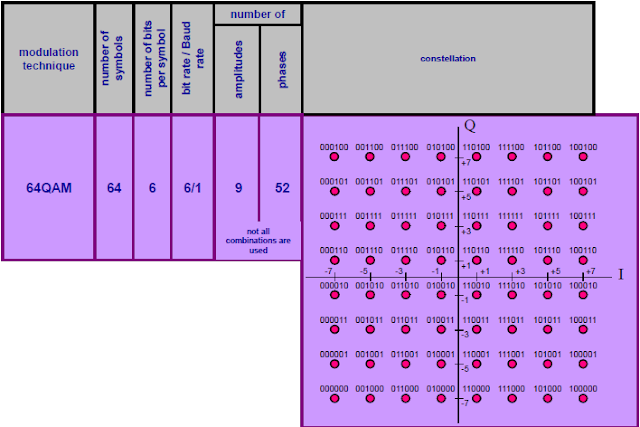Modulation:
# A baseband signal can not be sent directly to an antenna
- The signal is not broadcast over the air interface
# The baseband signal or “message” is carried by a carrier over the air interface
- The carrier is modulated by the base-band signal by the transmitter and demodulated by the receiver.
#The modulation allows one to mix the message and the carrier
*There are 3 ways to modulate the carrier:
- The amplitude: the receiver can identify the bit by analyzing the amplitude
- The frequency
- The phase
#The 3G LTE uses 3 Quadrature Amplitude Modulations (QAMs) depending on the radio quality.
-QAM uses both the amplitude and the phase.
-The LTE supports in DL and UL the following modulations:
-QPSK, the most robust but the less efficient
- 16-QAM
-64-QAM, the less robust but the most efficient
QAM is a modulation method modifying the phase and the amplitude of the carrier signal.
QAM symbols are represented by the carrier signal being transmitted with specific phase / amplitude
(dictated by the message), for finite periods of time.
-One symbol is identified by a Q and an I value.
-Transmission channels with a limited bandwidth limit the amount of symbols per second (Baud rate) that can be transmitted. To increase the bit per sec (bps) capacity of a channel, while keeping the Baud rate at the low values imposed by the channel bandwidth, the symbols carry (represent) more than one single bit.
-Symbols will represent a number of n bits, increasing the channel capacity by a factor of n.
-The price paid is the presence of multiple symbols in the channel, increasing the probability of incorrect symbol identification at the receiver.
QPSK:
The QPSK is the most robust modulation. It can be represented by a constellation:
-The radius, R, represents the amplitude.
-The angle, φ, represents the phase.
There are 1 amplitude but 4 phases to 4 different states.
- 2 bits can be coded with 1 QPSK symbol.
The 16-QAM can modulate 4 bits per symbol.
The 64-QAM can modulate 6 bits per symbol.
In reception, it may be difficult to make the distinction between 2 states, i.e. 2-bit sequence. If the wrong state is selected, there are errors of reception.
The use of higher-order modulation provides the possibility for higher bandwidth utilization, that is the possibility to provide higher data rates within a given bandwidth.
#Before processing the data (bit stream) to send it on the air interface, the transmitter performs the encoding, to be able to detect or correct errors of reception.
#The amount of parity bits is defined by a rate, called coding rate
#The typical coding rates are ½, 2/3, ¾.
The coding methods are:
-Convolutional
-Turbo
*The combination of the modulation and the channel coding (identified by its rate) forms one of the possible Modulation and Coding Schemes
*The link adaptation is done by the selection of the most adapted modulation to the current radio
conditions.
The 3GPP defines 32 possible MCS
MCS corresponding to the CQI index such that the PDSCH could be received with a transport block error probability not exceeding 10 %
The best modulation does not always give the best performance. If the radio quality is not good enough, the receiver is not able to correctly decode the modulation. It may be more efficient to select a less robust modulation depending on the radio quality.
Coding rate = (transport Block Size + number of CRC bits)/number of bits transmitted on RF interface








